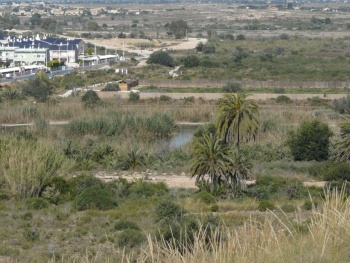
Mark Etheridge
A View overthe entrance to the Clot de Galvany reserve on the Los Arenales-Gran Alacant road
Overview
The Clot de Galvany is a small but extremely interesting nature reserve sandwiched between the N-332 road and the twin urbanisations of Gran Alacant and Los Arenales just south of Alicante. It forms part of the wider area known as the Cabo de Santa Pola. There is a variety of ecosystems, from wetlands through Mediterranean scrub, pine plantations and rocky hillsides giving a wide diversity in a confined area. The main pool is known as the Charco de Contacto with a hide on the far side; alongside it is a recently-developed wader scrape also with a hide (known by some as the "Zeiss hide" after its sponsor). Further on there is another hide overlooking a seasonally marshy area, and further still there is another hide overlooking a pool which lies beneath the rocky hill to the west - this hide is however often locked up.
Birds
Notable Species
White-headed Duck and Marbled Duck breed on the reserve, as well as Purple Swamphen
Rarities
A Baird's Sandpiper was reported in 2004
Check-list
{{BirdsSeeSquacco Heron, Cattle Egret, Little Egret, Grey Heron, Purple Heron, Eurasian Spoonbill, Common Shelduck, Mallard, Common Pochard, Tufted Duck, Osprey, Common Kestrel, Common Moorhen, Eurasian Coot, Black-winged Stilt, Pied Avocet, Little Ringed Plover, Ringed Plover, Kentish Plover, Eurasian Golden Plover, Grey Plover, Red Knot, Sanderling, Little Stint, Curlew Sandpiper, Dunlin, Ruff, Common Snipe, Black-tailed Godwit, Bar-tailed Godwit, Whimbrel, Spotted Redshank, Common Redshank, Common Greenshank, Marsh Sandpiper, Green Sandpiper, Wood Sandpiper, Common Sandpiper, Arctic Skua, Little Gull, Mediterranean Gull, Slender-billed Gull, Black-headed Gull, Audouin's Gull, Lesser Black-backed Gull, Yellow-legged Gull, Caspian Tern, Sandwich Tern, Common Tern, Little Tern, Gull-billed Tern, Whiskered Tern, Black Tern, Common Swift, Pallid Swift, European Bee-eater, Eurasian Hoopoe, Lesser Short-toed Lark, Crested Lark, Eurasian Crag Martin, Barn Swallow, Northern House Martin, Meadow Pipit, Water Pipit, Spanish Yellow Wagtail, White Wagtail, Eurasian Robin, Black Redstart, Common Redstart, Whinchat, European Stonechat, Northern Wheatear, Black-eared Wheatear, Black Wheatear, Cetti's Warbler, Zitting Cisticola, Savi's Warbler, Sardinian Warbler, Blackcap, Common Chiffchaff, Willow Warbler, Firecrest, Spotted Flycatcher, Woodchat Shrike, Common Starling, Spotless Starling, House Sparrow, Chaffinch, European Serin, European Greenfinch, European Goldfinch, Eurasian Linnet}}
Other Wildlife
The area contains Ocellated, Red-tailed and Iberian wall lizards, Montpellier Snake, Field Mice and Pygmy Shrew. Rabbits are to be found in some numbers, providing a good food source for several raptors during the winter.
Site Information
History and Use
In 1978 the Clot suffered severe damage through property builders' attempts develop the area; serious drainage and earthworks took place which altered its unique natural features and functionality, these works were paralyzed by pressure from citizens and environmental groups..
Areas of Interest
Access and Facilities
The reserve is accessed from the El Arenales - Gran Alacant coast road opposite the turning to Santa Pola. There is a large parking/picnic area and an information centre.
From here, a main track takes you into the reserve, a walk of about 500 metres will bring you to the Charco de Contacto pool, and tracks radiate from here to pass through the reserve. They are popular with cyclists and walkers.
External Links
Content and images originally posted by Mark Etheridge




